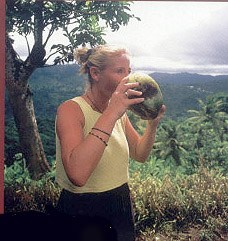 |
|
|
Introduced to the Caribbean in the mid -18th century the coconut is thought to have been imported here by traders plying their wares from as far away as the South Pacific. It is also thought that the seed of the coconut being so buoyant traveled around the world on the various currents of the oceans. This resourceful fruit with all of its fibre and oil was the perfect botanical boat. Indeed the coconut palm was destined to populate all of the warm climates of the globe due to its inherent ability to 'sail' its own ships on the tropical oceans. Flourishing in the warm, balmy temperatures of the islands, the coconut took root and has become a signature of the region, prominently displayed in every exotic portrayal of the Caribbean. From stem to leaf the coconut quickly became intrinsic to the country's culture and economy. Today its resourcefulness is acclaimed by St. Lucians. For the well-soused individual who has had just that little bit too much to drink the night before, the juice of the young fruit called 'coconut water' by islanders will neutralize the effects of a hangover. (Note well that there is a marked distinction between coconut water and coconut milk. The 'water' is found in the belly of the nut, whereas the milk is derived from grating the meat within the fruit, mixing this with ordinary water and squeezing out the liquid through a fine fabric such as muslin, gauze or cheesecloth.) Consumed just before going to bed following over-indulgence of food and drink, coconut water will guarantee one wakes up bright-eyed and bushy-tailed, none the worse for wear. But this is where things get a little ticklish and grey areas abound. There are some who profess that coconut water, while a panacea for all that ails digestion, should not be ingested too late at night for fear of excruciating belly cramps or even death! Then there are those who swear that coconut water combined with a touch of aloe, well blended together, makes what St. Lucians call "a coolin'" designed to purge the body, especially the digestive tract and 'clean the blood' of all impurities. This coolin' is an integral part of islanders' annual back-to-school ritual where well-meaning parents ensure that their children are thoroughly purged before facing the grueling demands of academia, free of all that might bind their bodies and minds such as the never-ending spicy home-made salads of green mangoes, sour tamarind and whatever else children in these parts pop into their mouths during the long, hot summer months. There are some who even say that the water of the young, still jelly-less coconut is the best and most natural liquid Viagra there is. Young and some not-so-young men are even willing to guarantee the potency of the coconut as an aphrodisiac or "front-end lifter" as they jokingly refer to the nut (pardon the pun). The fruit can also be grated and squeezed, boiled and the fat skimmed off to make coconut oil which local mothers swear by to keep babies' limbs supple. Young people also use this for smooth, blemish-free skin and older folk contend that it wards off rheumatism and other joint pains. But the benefits of the coconut palm are not solely confined to medicinal and exotic purposes. The palm is also used for the creation of beautiful arts and craft from wide-brimmed hats to tablemats and floor coverings. The fronds are also used for thatched roofs and in some parts huts are still made completely from the coconut tree. The wood from the plant that soars from 40 to 100 feet when fully grown, has also built bridges and houses. The benefits of the coconut to the economy of the island were so well recognized that in the late 1930's a group of coconut growers came together and formed the St. Lucia Coconut Growers Association. Thousands of hectares of land were put under coconut cultivation with copra – the sunned and dried nut – being one of the main exports. From this copra was made toilet and laundry soap, margarine, shortening and cooking oil, lotions and creams. Fodder and feed meal for poultry and cattle was also made from the discarded parts of the main product. The coconut lived up to its reputation as the total crop. However, in recent years, the fruit has gotten a bad rap on the international market with claims of its high content of bad cholesterol and while it still remains an integral part of islanders' way of life, the industry has suffered from the negative publicity. Bad press or not, the distinctive taste of the coconut is found in many tropical cocktails – daiquiris and scorpions, or have you tried one of the most popular local drinks – coconut water and Johnny Walker Black scotch whisky? No matter how you decide to try it, au naturel, right from the nut, mixed in a cocktail or even in food - there is no denying the wonderful taste of coconut milk in a chicken pelau - or perhaps the jelly of the fruit eaten straight up from the shell; your holiday will be complete only when you have savoured the sweet coconut. Then and only then, can you honestly claim: "I've tasted the Caribbean."
|
|
|
|
||||||||||||||||||||
|
© 2001-2005 Island Visions Ltd. |
 COCONUTS -
COCONUTS -